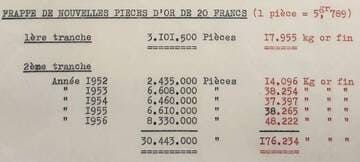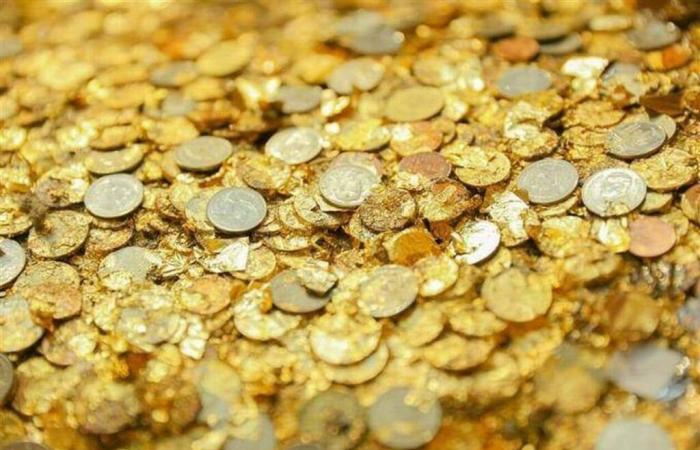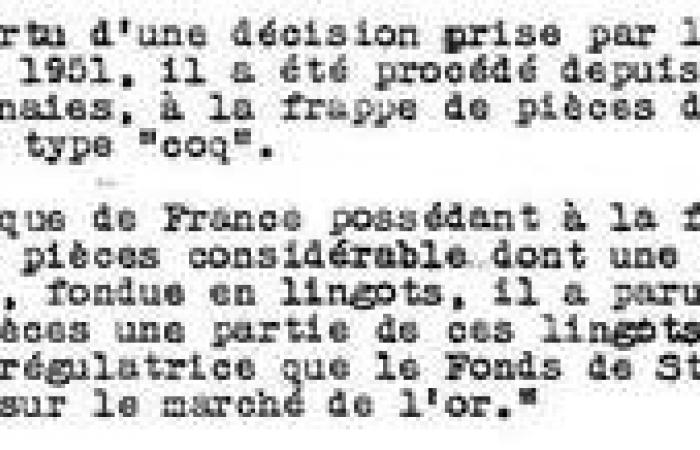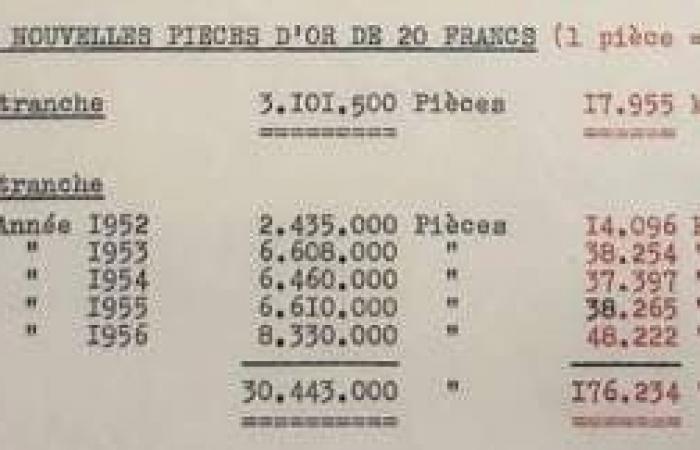While searching the archives of the Banque de France for an investigation, Yannick Colleu, expert in precious metals, made an astonishing discovery. The French state has distributed a “real fake” currency, illegally and in great secrecy. We tell you.
“A discovery worth its weight in gold”affirms Yannick Colleu. Because when we think of big scams, we think of scammers like Charles Ponzi and his famous pyramid, or rich businessmen with elaborate tax optimization tactics. No one would dare imagine that the State and our solid institutions could be behind deception. However, he benefited from this blind trust for almost ten years.
“From 1951 to 1960, illegally, and in the greatest secrecy, the Minister of Finance, with the approval of the Bank of France, had copies of gold coins manufactured and distributed. » This is what this specialist in precious metals observed, by delving into the archives of the Banque de France, and which he reports in his work The Gold of the French. We'll explain it to you.
“Illegal” solution to the crisis
It all began in 1951. France faced great financial difficulties after the war. “We had very little gold left at the end of the war, everything was melted down to buy ammunition”explains Yannick Colleu. Since the ratification of the Bretton Woods agreements in 1945, the defense of the gold market has been inseparable from the health of the economy, to maintain parity with the dollar, the only currency convertible into gold. “We had left the gold standard, and we were trying to follow the dollar” he specifies. Even more so, because two loans were contracted by the French State in 1952 and 1954, indexed respectively to gold and the Napoleon (20 franc gold coin with the value of a gold Louis).
The Minister of Finance at the time then found a golden solution to calm the market in a painless, but above all illegal, way. “We took the identical designs from the 20 franc coins minted from 1907 to 1914, of the “rooster” type and demonetized in 1926. Then they were put back into circulation without saying anything. »
Read also: “A very good safety cushion”: how to invest in gold and avoid scams?
“Open Secret”
And this, despite the reluctance within the General Council of the Bank of France. And what’s more, in the greatest secrecy: “ The governor reports to the Bank of France so that it can produce counterfeit demonetized currencies, there is not even a decree as is usually the norm. He just sends a letter indicating that it was his predecessor who took the initiative.smiles the passionate 72-year-old retiree. This is not even mentioned in the annual report of the Administration of Coins and Medals. »
“It’s an open secret confirms Arnaud Manas, head of the heritage department of the Banque de France. This information was also mentioned in Parliament in 1976.”
In total, 37.5 million “fake” coins were minted. All this to allow the market control body, the Exchange Stabilization Fund, to stabilize the gold market. Nowadays, copying demonetized currency is an offense according to article 442-3 of the Penal Code.
Read also: Gold owl found: what is its true value today?
“We have wronged the French”
But very quickly, these pieces begin to raise questions. Even if the copies are meticulously made, perfectly imitating their predecessors, even going so far as to bear the same vintage (the year of minting, from 1907 to 1914), their brand new brilliance arouses the suspicion of professionals. “We called it fake!says Yannick Colleux. In January 1952, the Banque de France was forced to issue a press release to explain itself. »
Gold leaf on the cake: another difference, the redr color than the previous pieces, would be linked to another more silvery and less golden alloy, according to the expert. He claims that these coins have a gold content lower than the official gold content, i.e. 897.3 thousandths instead of 900 thousandths. Thus, for several decades, “the French, believing they were buying guaranteed gold coins, were wronged. » In total, of the 217 tonnes of gold put into circulation, 654 kg of fine gold would have been saved by the State. To justify this accusation, he notably highlights a document found in the archives of the Banque de France, the title of the copies (see below). “A 20 franc coin was issued at a weight of 5.8065 g of fine gold while copies were requested at a weight of 5.789 g of fine per coin. »

For its part, the Banque de France disputes: “The parts have not been reduced and are within manufacturing tolerances. In addition, parts wear out and lose mass. The fine rate (purity of the alloy) cannot be absolutely precise. »
Read also: Savings: gold much more profitable and better tax-exempt than we think
Copies taxed as much as the real ones
But much more than the gold content, it is the taxation that the specialist in the taxation of precious metals denounces today, which is of little benefit to the holders of these real fake coins as savings. “These coins are not currencies, but tokens, and should therefore be exempt up to €5,000 on resale. But today, the tax authorities apply the 11.5% tax on the sale price as if it were real money.”
Taxation justified by Arnaud Manas: “When it intervened in the gold market (before 1973), the Bank of France recognized these napoleons as currencies in the same way as the real ones. » A real counterfeit currency worth its weight in gold.








